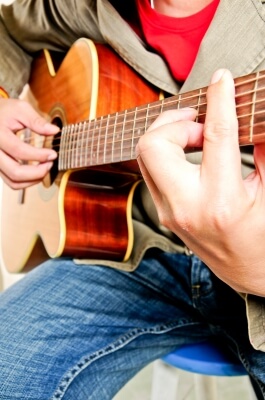How To Read Music Notes
and Not sound BoringYou’ve heard it before – people learn how to read music notes and sound cold and lifeless when they play. What’s going on?
When you learn how to read music notes the wrong way, it can kill your musical groove. And unfortunately, the more you practice, the worse it gets.
Let’s see what is thrashing your music reading – and how to avoid it.
Question: Did you learn your language by reading a book?
I doubt it.
That would be like trying to speak French from a book – without the real context of people, sounds, inflections, nuances and culture.
You would sound cold and robotic.
At best, you might memorize a basic vocabulary – but without heart, emotion or warmth. Your parlez-vous would sound like junky poo.
How can this be avoided?
music is a language
Every language is both Visual and Aural.
You can’t just memorize the visual symbols and hope to speak it well.
Likewise, you cannot learn how to read music notes by just memorizing the notation symbols.
“But Isn’t Music Really Just Math?”
In a word, NO.
Yes – rhythms are mathematical in how they relate to each other.
However, music notes perfectly played – do not make perfect music.
In other words, you can learn how to read music notes “correctly” with mathematical precision, and still not make music. Math and music notation are similar, but…
- Math doesn’t feel good.
- Numbers don’t touch us emotionally.
- A metronome is precise, but boring.
It’s Not What You Say, But HOW You Say It
Learning how to read music notes the right way requires more than memorizing the duration of the note. (a whole note gets 4 counts).
In addition, you must learn how to read (and perform) music notes in the context of a real musical setting.
A musical performance contains both VISUAL AND AURAL decisions:
- Do you accent the note?
- Gently slide in to it?
- End it abruptly?
- Will you separate the notes (staccato) or let them flow together (legato)?
- Should it “lay back”… drive ahead… or sit right in the middle of the beat?
- Is the composition sad, happy or angry?
- Or maybe patriotic – like a march?
- Does it swing like Jazz or Reggae?

So, there’s more than one way to play a music note.
It is possible to play it “correctly” but without feeling or meaning.
As a result, your musical performance is lifeless.
Yes, you can recognize a quarter note, a half note and a whole note. You have indeed learned how to read music notes.
Unfortunately, you just don’t know what to do with them.
Music Is Emotion
There are many ways to say “I Love You.”
Likewise, there are just as many ways to play music notes.
Notes are like words – fluid and varied in different contexts.
Even though there are only 12 notes, we use these 12 notes to create a wide range of musical styles: from exciting, angry and intense to gentle, romantic and worshipful.
Consequently, these 12 notes can be read, interpreted and performed different ways.
Math, on the other hand, is not fluid. It is precise, consistent and unchanging with emotion.
2 + 2 will always = 4.
Yes, one could argue music is mathematical principles based on sound vibrations and timbres. And that is correct.
But I am not addressing the physics of music – only the way in which we mentally organize, perceive and perform it.
Music is NOT math.
Music is full of expressive choices.
These choices help us phrase (articulate/speak) the notes. Phrasing gives music a personality or style.
Every genre or style of music has unique musical phrasing.
As a result,
Musicians phrase according to the style or genre.
Music notes then have life and energy because they are performed in context.
The Secret Sauce
Consequently, the best way to learn how to read music notes is within the context of real music.
Phrasing becomes second nature – without effort.
It is organic and natural… like living in France helps you absorb the nuances and phrasing to speak French fluently and authentically.
This is why Blues guitar sounds different from Flamenco.
And Country will never sound like Baroque.

Three HUGE Benefits
When you learn to read music notes this way – you gain three huge benefits:
- First, your performance is mathematically accurate. (timing & tempo)
- Second, your music reading is alive and expressive. (emotional impact)
- Third, you can listen, respond and perform in different musical styles.
This is the secret sauce that professional musicians have.
They have learned how to read music notes with amazing accuracy. But they also do much more. Their performance is emotional, alive and exciting.
As a result, their phrasing causes the music to speak beyond the written page.
It’s alive.
Musical Conversation
As a professional musician, I listen and talk (musically) along with other musicians when we play together.
You too, can learn how to read music notes this way.
If you are performing as a soloist, in a band, or in a large cast of hundreds, you simply listen and respond accordingly.
When you learn to read music notes the right way, this is normal.
How do you avoid the Wrong Way?
There are many “how to read music notes” books/courses available.
Just google how to read music notes and see what you find. But be warned – You get what you pay for.
Yes – you can buy a $10.00 book, memorize Every Good Boy Does Fine and some basic note values. Then what?
You didn’t spend much money, but in the long run – it’s a very expensive mistake.
- The process will make you memorize notation symbols out of context.
- Your vocabulary will sound mechanical, like reading a foreign language.
- Ultimately, you can’t fit in and adapt with other musicians.
- And the bottom line is that YOU STILL CAN’T READ MUSIC – just recognize some notation elements
Now don’t misunderstand, I’m not trying to criticize any book or method.
If you’re getting the results you want – Bravo. Don’t change a thing.
But, if you’re still struggling, there is a better way. You need a system to put it all together.

Learn From Experience
My father was a professional musician.
He taught hundreds, maybe thousands of aspiring musicians how to read music. He was a concert pianist and later became a band director and educator.
Obviously, when your job is to teach a room full of aspiring musicians how to read music notes – you have to know what you’re doing.
There is no “fake it till’ you make it” allowed – unless you want a room full of chaos.
So, Dad developed a system that got results. This proven system became the core of my See it, Say it, Play it process:

- SEE the notation and understand it.
- SAY the rhythm out loud “in time”.
- PLAY the music on an instrument.
Eventually, the three steps morph into one integrated process.
VISUAL, AURAL & MOTOR SKILLS COMBINE.
That’s the right way. It’s the most natural and powerful way to learn to read music notes.
Start Correctly and Get It Right the First Time
Dad was my first music teacher.
Lucky for me, right?
Even so, he wasn’t around all the time.
That left me guessing. I had to wait until he came home to be sure I was reading a rhythm correctly.
Without someone to ask, how can you be sure? (Like trying to hire a live-in French tutor 24/7).
As a result, when I became an adult, professional musician, I knew what I had to do.
I began to create a DIY (do it yourself) system to learn how to read music notes the right way –
- play-along music tracks of different musical styles/genres
- practical music theory lessons
- drills, exercises and worksheets
- learn a real instrument (but for under $10.00)
- avoid confusion and information overload by teaching one-note-@-a-time
– DIY, at your own pace, in the privacy of your home.
I committed hours, days… years to the project. And I tested it on hundreds of aspiring musicians of all ages.
How To Read Music: See it, Say it, Play it is my solution.
I believe it is the most effective music tool available to learn how to read music notes quickly, precisely and musically.
Am I Bragging?
If telling the truth is bragging – then Yes, I am.
The bottom line is… It works.
For more details, this article lists even more advantages from learning how to read music the right way.
Conclusion
Learning How To Read Music Notes is not supposed to be a fight!
Bad methods can make it feel like you’re in a boxing match…
You vs Music.
You can end the fight.
It IS possible to learn to read music a better, more effective way.
So, if you’re struggline with reading music, it’s most likely because…
- Nobody can learn how to read music notes correctly without a musical context. The language of music is fluid and alive – not just memorizing symbols.
- You should learn how to read music notes along with some basic, practical music theory. It helps you put it all together.
- You will not learn how to read music notes without playing an instrument. It involves the eyes/ears/hands in an active, learning experience.
- The plan you’re following isn’t complete. You need a proven SYSTEM that teaches you only what you need, when you need it, one note at a time.
How To Read Music – See it, Say it, Play it provides everything you need.

It is possible to learn how to read music notes without sounding mechanical, lifeless and boring.
Learn The Right Way
Too many people keep trying to learn the hard way – because that’s how “everybody” does it.
However, you don’t have to be one of them. There is a better way.
Learn how to read music notes the right way… in context, playing along with real musicians, in real musical styles, with a real instrument.
Try it. I promise you won’t regret it. You’ll enjoy the benefits forever.